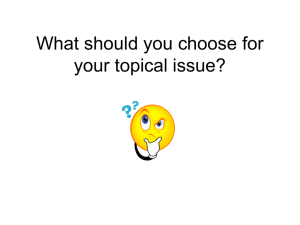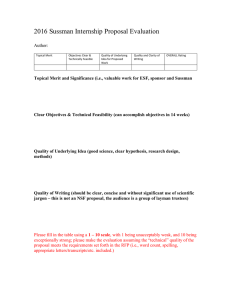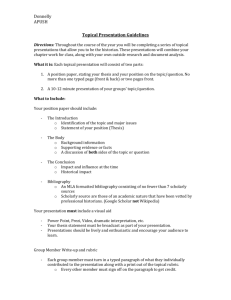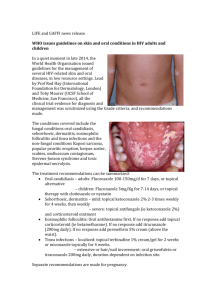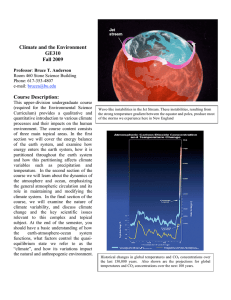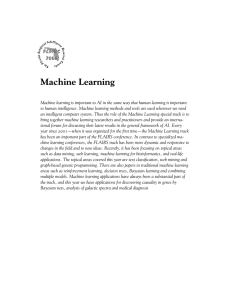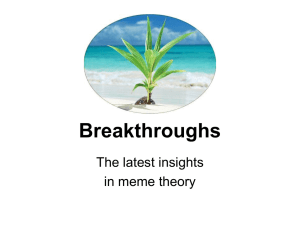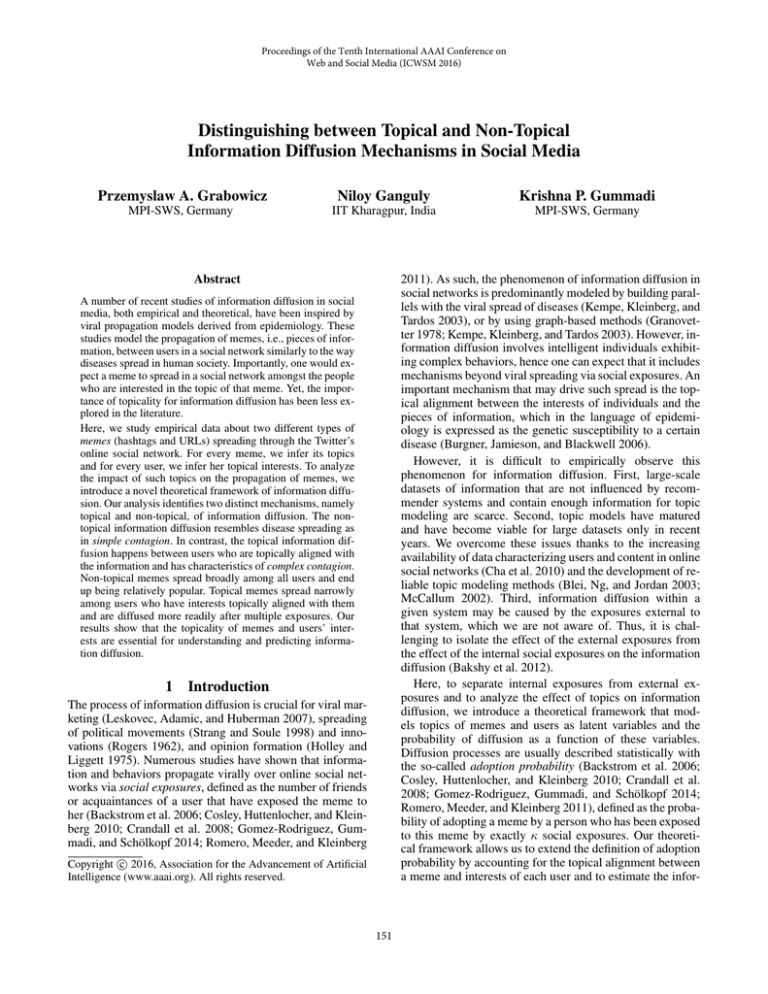
Proceedings of the Tenth International AAAI Conference on
Web and Social Media (ICWSM 2016)
Distinguishing between Topical and Non-Topical
Information Diffusion Mechanisms in Social Media
Przemyslaw A. Grabowicz
Niloy Ganguly
Krishna P. Gummadi
MPI-SWS, Germany
IIT Kharagpur, India
MPI-SWS, Germany
2011). As such, the phenomenon of information diffusion in
social networks is predominantly modeled by building parallels with the viral spread of diseases (Kempe, Kleinberg, and
Tardos 2003), or by using graph-based methods (Granovetter 1978; Kempe, Kleinberg, and Tardos 2003). However, information diffusion involves intelligent individuals exhibiting complex behaviors, hence one can expect that it includes
mechanisms beyond viral spreading via social exposures. An
important mechanism that may drive such spread is the topical alignment between the interests of individuals and the
pieces of information, which in the language of epidemiology is expressed as the genetic susceptibility to a certain
disease (Burgner, Jamieson, and Blackwell 2006).
However, it is difficult to empirically observe this
phenomenon for information diffusion. First, large-scale
datasets of information that are not influenced by recommender systems and contain enough information for topic
modeling are scarce. Second, topic models have matured
and have become viable for large datasets only in recent
years. We overcome these issues thanks to the increasing
availability of data characterizing users and content in online
social networks (Cha et al. 2010) and the development of reliable topic modeling methods (Blei, Ng, and Jordan 2003;
McCallum 2002). Third, information diffusion within a
given system may be caused by the exposures external to
that system, which we are not aware of. Thus, it is challenging to isolate the effect of the external exposures from
the effect of the internal social exposures on the information
diffusion (Bakshy et al. 2012).
Here, to separate internal exposures from external exposures and to analyze the effect of topics on information
diffusion, we introduce a theoretical framework that models topics of memes and users as latent variables and the
probability of diffusion as a function of these variables.
Diffusion processes are usually described statistically with
the so-called adoption probability (Backstrom et al. 2006;
Cosley, Huttenlocher, and Kleinberg 2010; Crandall et al.
2008; Gomez-Rodriguez, Gummadi, and Schölkopf 2014;
Romero, Meeder, and Kleinberg 2011), defined as the probability of adopting a meme by a person who has been exposed
to this meme by exactly κ social exposures. Our theoretical framework allows us to extend the definition of adoption
probability by accounting for the topical alignment between
a meme and interests of each user and to estimate the infor-
Abstract
A number of recent studies of information diffusion in social
media, both empirical and theoretical, have been inspired by
viral propagation models derived from epidemiology. These
studies model the propagation of memes, i.e., pieces of information, between users in a social network similarly to the way
diseases spread in human society. Importantly, one would expect a meme to spread in a social network amongst the people
who are interested in the topic of that meme. Yet, the importance of topicality for information diffusion has been less explored in the literature.
Here, we study empirical data about two different types of
memes (hashtags and URLs) spreading through the Twitter’s
online social network. For every meme, we infer its topics
and for every user, we infer her topical interests. To analyze
the impact of such topics on the propagation of memes, we
introduce a novel theoretical framework of information diffusion. Our analysis identifies two distinct mechanisms, namely
topical and non-topical, of information diffusion. The nontopical information diffusion resembles disease spreading as
in simple contagion. In contrast, the topical information diffusion happens between users who are topically aligned with
the information and has characteristics of complex contagion.
Non-topical memes spread broadly among all users and end
up being relatively popular. Topical memes spread narrowly
among users who have interests topically aligned with them
and are diffused more readily after multiple exposures. Our
results show that the topicality of memes and users’ interests are essential for understanding and predicting information diffusion.
1
Introduction
The process of information diffusion is crucial for viral marketing (Leskovec, Adamic, and Huberman 2007), spreading
of political movements (Strang and Soule 1998) and innovations (Rogers 1962), and opinion formation (Holley and
Liggett 1975). Numerous studies have shown that information and behaviors propagate virally over online social networks via social exposures, defined as the number of friends
or acquaintances of a user that have exposed the meme to
her (Backstrom et al. 2006; Cosley, Huttenlocher, and Kleinberg 2010; Crandall et al. 2008; Gomez-Rodriguez, Gummadi, and Schölkopf 2014; Romero, Meeder, and Kleinberg
c 2016, Association for the Advancement of Artificial
Copyright Intelligence (www.aaai.org). All rights reserved.
151
mation diffusion from both internal and external sources.
Furthermore, we hypothesize that there exist two different
mechanisms of information propagation, namely, a topical
and non-topical information diffusion. Under this hypothesis, topical information would start to spread from the enthusiasts or experts of that topical domain. Then, it would diffuse narrowly to other members of this domain. Non-topical
information would not be limited by its topical domain. If
such hypothesis is correct, then one can expect that topical
and non-topical information diffusion have different properties. Here, we aim to identify characteristics specific to each
of these two mechanisms. Finally, having the two mechanisms identified and characterized, it is crucial to relate them
to existing theories of information diffusion. The sociological theory of complex contagion suggests that multiple social exposures are important for the diffusion of novel and
controversial information (Centola and Macy 2007), while
the theory of simple contagion posits viral spreading after
the initial exposure. How these theories relate to topical and
non-topical information diffusion? These are some of the
questions that we address in this study.
1.1
tion over a constant number of topics. To evaluate how topically narrow are memes and users’ interests, we compute the
entropy of their corresponding topical distributions. Thanks
to this procedure, we distinguish between topical and nontopical memes and users. We say that a meme is topical if
it is strongly associated with a topic, whereas a non-topical
meme is weakly and equally associated with all topics. Importantly, we define the topical alignment between a meme
and interests of a user as a cosine similarity of their respective topical distributions. We exploit this topical alignment
to compute the probability of adoptions triggered either via
sources internal or external to Twitter (Section 4). We find
that topical memes are likely to be topically aligned with
the interests of people who adopt them, either via internal or
external exposures. We leverage out theoretical framework
further, finding that:
• A considerable fraction of memes are topical. (Section 3)
• We show that adoptions of topical memes are easier to
predict than the adoptions of non-topical memes. (Section 5.1)
• For the topical information diffusion, the probability of
adoption steadily increases with the topical alignment
between user’s interests and a meme, whereas for nontopical information diffusion the probability stays flat or
increases considerably less. (Section 5.1)
• Topical information diffusion profits more than nontopical diffusion from multiple exposures to a meme;
thus, it resembles complex contagion. We capture it by
introducing a novel metric of spreading persistence. (Section 5.2)
• A large fraction of adoptions happens via seed adopters
exposed to external sources. The seed adopters of topical memes are relatively more aligned with the meme
than other adopters and the seed adopters of non-topical
memes. (Section 5.3)
• The diffusion of URLs is about twice more intense via external rather than internal sources, whereas the diffusion
of hashtags has similar intensity both for external and internal exposures. (Section 5.3)
Present work
Note that, to understand the importance of topicality for information diffusion, we require (i) a closed social system
that does not implement any personalized recommendation
algorithm1 , (ii) a comprehensive and independent annotation
of topicality of users and diffused pieces of information, and
(iii) a theoretical framework that is able to estimate the effect of internal and external social exposures on information
diffusion and to quantify topicality of memes and users.
To this end, we analyze a dataset from Twitter containing
all public tweets that were messaged during the observation
period of three months in mid-2009 and a full snapshot of
the follower graph from the end of that period. During that
time, there were no personalized recommendations in Twitter and no other mechanisms than follower links to subscribe
to other users. Hence, we are able to measure information
diffusion in a natural setting, namely in an online social network that is hardly affected by any recommender system. We
consider two distinct types of information that diffuse over
the follower graph, namely hashtags and URLs, which for
simplicity we jointly call memes. We say that a user diffuses
or adopts a meme if she writes it in one of her tweets.
Next, we split the dataset chronologically into two parts
(see Figure 1). We process the prior part to infer the topics of memes and users’ interests, whereas we use the latter
part to perform an independent analysis of information diffusion. More specifically, using nouns extracted from past
tweets we infer with an unsupervised method, namely with
Latent Dirichlet Allocation, i.e., LDA (Blei, Ng, and Jordan
2003), the topical distributions of active users and popular
memes (Section 3). As such, in our theoretical framework,
topics are mixtures of words that frequently appear together.
Each user and meme is represented by a topical distribu-
1.2
Related work
Some of our results can be interpreted with the sociological theory of complex contagion (Centola 2010; Centola and Macy 2007). This theory posits that “high-risk”,
“novel”, “unproven”, or “controversial” information spreads
via “wide bridges”, namely via multiple social exposures
or strong ties. As we show later, topical memes convey
such information. Romero et al. report that successive social exposures to political hashtags tend to increase adoption probability more than multiple social exposures to
idioms (Romero, Meeder, and Kleinberg 2011). The authors explain these diffusion classes with complex contagion mechanism. Our work generalizes their analysis and
methodology, in the sense that we do not focus on a set
of specific topics (e.g., politics and idioms), but instead we
study a quantifiable and robust topical space, which represents such specific topics, yielding consistent results. Our
1
At the time of data collection, all follower links were created
by users themselves without the influence of any personalized recommendation algorithm.
152
findings suggest that topical information diffusion is related
to complex contagion.
It is intuitive that human behavior is largely related to
multi-dimensional personal characteristics of people, such
as topical interests or private traits (Kosinski, Stillwell, and
Graepel 2013). For instance, some of the recently proposed
models suggest that latent factors impact information diffusion (Barbieri, Bonchi, and Manco 2012; Du et al. 2013)
and measure topical social influence (Weng et al. 2010;
Bi et al. 2014). Moreover, recommender systems exploiting the premise of latent factors predicting content consumption are widely deployed (Ricci, Rokach, and Shapira
2011). However, empirical studies of information diffusion in social media tend to focus either on predictions
of the size of social cascades (Ma, Sun, and Cong 2013;
Weng and Menczer 2014), analysis of the structure of the
cascades (Goel, Watts, and Goldstein 2012), or detecting
influential spreaders (Cha et al. 2010), which are macroscopic and mesoscopic properties of information diffusion.
A few empirical works study the information diffusion at the
microscopic level. These studies explore, for instance, the
classes of information diffusion for specific topics (Romero,
Meeder, and Kleinberg 2011), the impact of activity similarity on the probability of interaction (Crandall et al. 2008),
and the predictiveness of limited content-based features for
future adoptions (Yang et al. 2012; Yuan et al. 2016). Thus,
to our knowledge, our work is the first large-scale empirical
study systematically analyzing the relation between topicality and mechanisms of information diffusion and the extent
to which topical alignments affect information diffusion.
2
Iran election
British election
Well-being
Viral marketing
Smart devices
mousavi, basij, khamenei, ppl, protesters, rally
bbc, london, bnp, news, brown, bit
success, happiness, einstein, albert, john, failure
marketing, business, twitter, media, blog, site
iphone, apple, app, mac, macbook, wwdc
Table 1: An example of five topics detected by LDA and
words associated with each of them. The words are ordered
by their relevance to the topic. (Words “albert” and “einstein” are associated with one of the topics because his sayings are quoted several times within that topic.)
at least in one tweet. Naturally, at the moment of posting the
meme, the adopter becomes an exposer of the meme to all
her followers.
We analyze adoptions that happened during the period
of three months, from June to August 2009. During this
time users posted nearly a billion of tweets. We consider
only the memes that emerged during that period, specifically during June. In other words, we do not consider memes
that were born before that period. This constitutes a difference from the prior works (Gomez-Rodriguez, Gummadi,
and Schölkopf 2014), which tracked also the memes that
emerged before the observation period, hence underestimating the number of social exposures.2 We focus on memes
that were used predominantly in English tweets. Specifically, we analyze the memes for which at least 90% of tweets
were in English. To detect the language of tweets we use
a state-of-the-art language detection tool for Twitter data
(Nakatani 2012). Furthermore, we report results only for the
memes that have been adopted by at least 100 unique users.3
Overall, we analyze 704 hashtags adopted 480k times by a
total of 330k unique users and 3745 URLs adopted 1.2m
times by a total of 610k unique users.
We divide the three-months long dataset into two parts.
The first part consists of all tweets from June, while the second part consists of all tweets from July and August (Figure 1). We use the first part of the dataset solely to infer
topical distributions of users’ interests and memes emerging
during that month. This partition allows us to keep the topic
modeling independent from the statistical analysis, which is
performed solely on the second part of the dataset.
Dataset
We analyze a dataset from Twitter that is nearly complete and contains all public tweets produced by users until
September 2009 and a snapshot of the social graph crawled
in September 2009 (Cha et al. 2010). In Twitter, a user can
post short messages, called tweets, that are delivered to all
her followers, namely all the users who follow her in the follower graph. (The users who are followed by the user are
her followees.) Such messages can contain memes, so the
memes can diffuse over the follower graph. Importantly, at
the time period when our dataset was gathered, there were
no other ways than the follower links to directly receive content from other users. We study the diffusion of two types of
memes: hashtags and URLs. We say that a user becomes an
adopter of a meme and starts to spread it once she posts it
3
Topicality of memes and users
Here, we describe how we obtain the topical distributions of
memes and users’ interests. Then, we introduce the notion
of topicality to distinguish between topical and non-topical
memes and user’s interests based on their respective topical distributions. Finally, we introduce the topical alignment
between a meme and user’s interests.
2
The user could have been exposed to the meme before the observation period. If this happens and one does not have knowledge
about it, then the real social exposure is higher than the one estimated based solely on the observation period. Our dataset covers all previous months apart from the three-months long period of
observation. Thus, we can accurately estimate the real number of
exposures.
3
We obtain qualitatively the same results for lower thresholds.
Figure 1: Timeline of the dataset illustrating the design of
the study. The gray area marks the period of analysis.
153
The most topical hashtags
Examples of tweets hand-picked from 30 chronological tweets from the beginning of June 2009
Hashtag
Topic
#ashraf
Iran election
#electionstudio
British election
1. bnp is a left wing party. so were the german national socialists. #electionstudio
2. #electionstudio this bnp guy is a lunatic frankly. indigenous population? if it weren’t for immigration britain would not exist at all.
3. #electionstudio i got very excited last night when purnell resigned but now can’t see a leadership challenge coming from anywhere
#vene2ia
Well-being
1. without freedom of choice there is no creativity kirk, star trek #vene2ia
2. it wasn’t until quite late in life that i discovered how easy it is to say ”i don’t know!” somerset maugham #vene2ia (via @vene2ia)
3. rt @vene2ia: children are the living messages we send to a time we will not see john w. whitehead #vene2ia
#smum
Viral marketing
#mytouch
Smart devices
Hashtag
Topic
#uknowyouugly
-
1. #uknowyouugly when you’re at the zoo and the monkeys run from you
2. #uknowyouugly when u gota get fresh to go to the grocery store
3. #uknowyouugly when they ban you from the mac store
#unala2009
-
1. getting ready for my first unconference... the first one might as well be a big one! very excited. #ala2009 #unala2009
2. got new business cards designed by my son. unconference tag #unala2009 per conference wiki. ala facebook meetup: http://tinyurl.com/loayhl
3. just for clarification, friday’s unconference is at the chicago hilton, not the palmer house hilton. hth #ala2009 #unala2009
#skiphop
-
1. i just entered to #win a #skiphop bag with a #beautyfix kit in the #99daysofsummer #contest at #modernmom! http://bit.ly/wetvi
2. modernmom i just entered to #win a #skiphop bag with a #beautyfix kit in the #99daysofsummer #contest at #modernmom! http://bit.ly/p29uz
3. i just entered to #win a #skiphop bag with a #beautyfix kit in the #99daysofsummer #contest at #modernmom! http://bit.ly/7ap8x #trackle
#sexisbetter
-
1. #sexisbetter wen your drunk
2. #sexisbetter with a scorpio! (guess what sign i am) ;-)
3. #sexisbetter when its anywhere but a bed
#besthead
-
1. #besthead when dey don’t expect it baq.. lol
2. #besthead is when u black out and just pass out now dats da best
3. #besthead was in the morning right after she brushed her teeth,she went to work!! u heard me (master p voice)
1. canadian friends of a democratic iran urge us president to ensure ashraf residents treated according international law #iran #ashraf #rajavi
2. suppressive forces heavily present in streets of iran capital to prevent protests #iran #iranelection #tehran #neda #rajavi #ashraf
3. how u can help iranians http://tinyurl.com/m8fun4 #iranelection #tehran #azadi #ashraf #rajavi #neda #basij #iran #gr88 rt rt rt
1. learn how to blog your way to success at social media university milwaukee http://ow.ly/g83u (last day for early bird pricing) #smum
2. lrt @philgerb: rt @dnewman:great article on benefits of audience tweeting during your presentation http://bit.ly/rdgsl good 2 know 4 #smum!
3. l@backseatgaffer glad you found it. you can sign up even if you’re not going to #smum. details: http://bit.ly/3qyhot reg: http://bit.ly/zvpeh
1. mytouch3g ordering starts tomorrow, very excited #tmobile #android #mytouch3g
2. im thinking of getting the tmobile #mytouch phone, i want to know, what do you all think of the phone? should i get it?
3. if you’re using a #bold, #curve, #g1, #mytouch or an #iphone you should download @loopt an amazing lbs networking app
The least topical hashtags
Examples of tweets hand-picked from 30 chronological tweets from the beginning of June 2009
Table 2: The top five most and least topical hashtags. For each hashtag, we show three exemplary tweets and a topic corresponding to this hashtag. The least topical hashtags are not associated with a specific topic. In this list, we omit all hashtags that
co-appear with the listed hashtags.
3.1
Topical distributions
3.2
Topicality
To measure how much topical a meme or a user’s interests
are, we compute the entropy H of their respective topical
distributions. The higher the entropy, the less topical the
meme or the user are, and vice versa. It follows that the most
topical would be a meme that is associated only with a single topic, whereas the least topical would be a meme that is
equally associated with all topics, i.e., has a uniform distribution over all topics. Most of memes is between these two
extreme examples. The distributions of entropy resemble a
normal distribution (Figure 2). We refer to the 25% most topical memes and users as topical, whereas to the 25% least
topical as non-topical. We establish this distinction for the
sake of clarity, however, other thresholds (e.g., at 50%) give
qualitatively the same results. In the remainder, we present
results both for topical and non-topical memes and users.
We list the most and the least topical memes in Table 2. For instance, hashtags #ashraf and #electionstudio
correspond to political elections in Iran and Great Britain,
#vene2ia represents a motivational website, #smum is about
a newly-established viral marketing school, and #mytouch
corresponds to a newly released smartphone. Note these
We define topical distributions for each meme and user
based on all tweets posted in June. First, we filter out the
tweets that are not written in English. Second, we extract
from remaining tweets all nouns and proper nouns using a
state-of-the-art POS-tagger for Twitter data (Owoputi et al.
2013). We choose nouns and proper nouns, because they encapsulate the semantics of tweets. We represent each meme
as a bag of unique nouns that appeared in tweets containing this meme and each user as a bag of unique nouns that
were tweeted by this user. Next, we model the topics of users
and memes with LDA performed for 100 topics and 1000
iterations (McCallum 2002).4 Hence, the topics of user’s
interests and a meme are represented by distributions over
100 topics. Examples of topics inferred with this method are
shown in Table 1. Note that each such topic gathers related
terms. We discuss these topics further in the following paragraphs.
4
We also tested lower and higher numbers of topics, finding
similar results both qualitatively and quantitatively.
154
topical
C
URLs
non-topical
hashtags
A
Even if a meme is perfectly non-topical (has a uniform distribution over topics), its topical alignment with a user that
has interests distributed uniformly over topics will be 1.
B
4
D
Figure 2: The distribution of entropy of topical distributions
of (A-B) memes and (C-D) user’s interests. The memes or
Users’ interests with the lowest entropy are the most topical, while the memes with the highest entropy are the least
topical.
4.1
Extending the definition of adoption
probability
One can reason about information diffusion by defining exposure event as a tuple (user, meme, exposers, adoption
state) that represents a user being exposed by a given set
of exposers to a meme that she has not adopted yet. Naturally, the set of exposers may be empty, if the user has not
been exposed to the given meme yet by anybody. The set of
exposers can only grow in time, as more people adopt the
given meme. The adoption state tells us if the meme will be
adopted before the appearance of a new exposer. If it gets
adopted, then we call such exposure event as an adoption
event, to distinguish it from all other exposure events. Note
that each exposure event can be characterized by the topical
alignment between a meme and a user. Some users in our
dataset do not have topical distributions defined. Thus, we
filter out all exposure events for such users.
Next we focus on exposure events with κ exposers.
Namely, we say that a user is κ-exposed to a meme at a
certain time, if κ distinct users that she follows adopted
the meme prior to this time and she has not adopted the
meme yet. The probability of adoption is defined (Cosley,
Huttenlocher, and Kleinberg 2010), as the probability that a
κ-exposed user will adopt the meme before getting (κ + 1)exposed to it, namely
hashtags correspond closely to the categories of information
that is predicted to spread via complex contagion, namely
novel, unproven, high-risk, and controversial information.
On the contrary, the least topical hashtags are mostly
Twitter idioms and neologism that can be understood directly from their names, i.e., #uknowyouugly, #sexisbetter,
#besthead, or are related to a popular lottery, i.e., #skiphop.
These idioms have a generic entertainment value. The hashtag #unala2009 corresponds to an un-conference, which is a
conference without agenda.
Strikingly, the distinction between topical, e.g., political,
hashtags versus idioms corresponds very closely to the categories of hashtags exhibiting complex and simple contagions described in (Romero, Meeder, and Kleinberg 2011)
(see Section 1.2). This indicates that the topical information
diffusion is related to complex contagion.
Finally, we note that topical memes are (42 ± 2)% more
likely to be adopted by a topical user than by a non-topical
user. This is in a sense the tip of the iceberg, because here we
do not take into account topical alignments between memes
and users, which increase the probability of adoption much
further.
3.3
The theory of adoption probability
In this section, we formally introduce adoption probability
and extend its definition to cover topical alignment. To this
end, we define the fundamental random events corresponding to the adoptions and exposures of memes. Then, we
exploit these events to define the adoption probability as a
function of social exposure and topical alignment. Also, we
show that the two channels of social influence, namely influence internal and external to Twitter, can be separated within
our model of information diffusion. We close this section
by introducing a new metric of spreading persistence that
quantifies the effect of multiple exposures on the probability
of adoption. The methods and definitions that we introduce
here can be used for studying information diffusion in various systems. In the remainder of this study, we apply this
theoretical framework to our Twitter dataset.
Pa (κ) = Na (κ)/Ne (κ),
(1)
where Ne (κ) is the number of users who were κ-exposed to
the information, and Na (κ) is the number of users that were
κ-exposed and adopted the meme before becoming (κ + 1)exposed. In other words, Ne (κ) and Na (κ) are the numbers
of exposure events and adoption events with κ exposers, respectively.5
The topical alignment between a meme and a
user
Once we have the topical distributions of memes and users,
we measure the topical alignment between a user and a
meme, denoted as S(user, meme), by computing the cosine
similarity of the corresponding topical distributions. The
topical alignment assumes values from 0 to 1, where 1 corresponds to the maximum possible alignment. The alignment
can be 1 both for topical and non-topical memes and users.
5
To decrease the impact of noise, we sum up the numbers of
events over all memes and then compute Pa (κ). Thus, in comparison with the traditional definition of adoption probability, we
weight popular hashtags proportionally more.
155
These two formulas subtract the probability of adoption
caused by external sources from the probability of any adoptions. Interestingly, Equation 9 subtracts the expected value
of adoption probability given that the conditional probability
distribution of similarity is P (S|κ). Intuitively, even if an individual is exposed to a meme on Twitter via κ > 0 internal
social exposures, he may adopt the meme from another topically related external source; we estimate and subtract the
impact of such
external phenomena on adoption probability
via the term Pa (0, S)P (S|κ)dS.
We extend the above standard definition of adoption probability to include a topical alignment. Namely, we define the
conditional probability that a κ-exposed user will adopt the
meme before getting (κ+1)-exposed when the topical alignment is S, namely
(2)
Pa (κ, S) = Na (κ, S)/Ne (κ, S),
where Ne (κ, S) and Na (κ, S) are the numbers of exposure events and adoption events with the social exposure κ and the topical alignment S. One can obtain onedimensional adoption probabilities Pa (κ) or Pa (S) by integrating Pa (κ, S) over κ or S, respectively, which gives
(3)
Pa (S) = Na (S)/Ne (S).
The adoption probability versus social exposure Pa (κ) has
been measured in multiple studies. In contrast, to our knowledge, the adoption probability versus a topical alignment
Pa (S) is measured for the first time in this study.
4.2
4.3
We define the persistence of information diffusion as the
ability of multiple exposures to boost information adoption. We introduce a new metric of spreading persistence (Romero, Meeder, and Kleinberg 2011) to capture this
complex contagion effect. We define this persistence as the
ratio between the average internal adoption probability at
several exposures and the adoption probability at one exposure, namely Persistence = Pai (κ)κ>1 /Pai (κ = 1), where
· is an average. Intuitively, our persistence metric captures
if multiple exposures boost information diffusion in comparison with a single exposure.
Diffusion via internal and external sources
Information can spread from sources that are internal or external to a given system (in our case, to Twitter). In general,
it is difficult to distinguish between internal and external exposures and to estimate their impact on information diffusion (Bakshy et al. 2012). Even if we know that a user follows a person that tweeted some meme and that this person
adopted this meme afterwards, we still do not know whether
this adoption was caused by the exposures via Twitter followers or via some other external sources. Furthermore, in
the next section we show that external adoptions are frequent
for information diffusion on Twitter.
Fortunately, our theory of adoption probability allows us
to differentiate between information diffusion via internal
and external sources, i.e.,
(4)
Pa (κi , κe , S) = Pai (κi , S) + Pae (κe , S).
In this study, the internal exposures are via the follower network of Twitter and we can estimate the number of such
exposures. By contrast, exposures via external sources are
opaque to us. In other words, we do not know κe , so we
marginalize it out from the last equation obtaining
5
Impact of topicality on adoption
probability
Here, we characterize topical and non-topical mechanisms
of information diffusion by studying the adoption probability versus social exposure and topical alignment. We analyze
separately the probability of adoption caused by internal and
external exposures. Among others, we show that the laws of
topical information diffusion apply both to internal and external information diffusion.
5.1
Topicality of memes vs adoption probability
We begin by measuring the distribution of social exposure
κ and topical alignment S(user, meme) for adoption and
exposure events of topical and non-topical memes (Figure 3). Prior works show that information cascades tend to
be shallow and have multiple seed adopters who learn about
the memes not from their friends, but from some external
sources (Goel, Watts, and Goldstein 2012). Here, we confirm that over 30% of hashtag adoptions and over 40% of
URL adoptions happened without a direct exposure through
follower links (see y-value at κ = 0 in Figures 3A-B). Furthermore, we notice that the distribution of S(user, meme)
differs for topical and non-topical memes. In particular, the
distributions of topical alignment S(user, meme) are skewed
to higher values for topical memes than non-topical memes.
For instance, about 40% of topical hashtags get adopted
when the topical alignment is higher than 0.4, whereas only
2% of non-topical hashtags are adopted when the alignment
is higher than 0.4 (compare blue and red solid lines in Figure 3C). Similar difference is present between topical and
non-topical URLs (Figure 3D). This signifies that topical
memes spread differently than non-topical memes.
Also, there exists a large difference between the cumulative distributions of adoption and exposure events for topical
(5)
Pa (κ, S) = Pai (κ, S) + Pae (S),
where κ ≡ κ and Pae (S) = Pae (κe , S)P (κe |S)dκe . Next,
we note that, if no internal exposures are present, i.e., κi =
0 and Pai (0, S) = 0, then the only influence remaining is
external, thus
(6)
Pa (0, S) = Pae (S).
This simple formula shows how to estimate the probability
of adoption via external exposures as a function of topical
alignment. Combining Equations 5 and 6 allows us to estimate the joint adoption probability via internal exposures,
namely
(7)
Pai (κ, S) = Pa (κ, S) − Pa (0, S).
Finally, we compute the marginalized internal adoption
probabilities Pai (κ) and Pai (S), as follows:
i
Pai (S) = Pa (S) − Pa (0, S),
i
Pa (κ) = Pa (κ) − Pa (0, S)P (S|κ)dS.
Persistence of spreading
(8)
(9)
156
hashtags
URLs
A
hashtags
B
URLs
C
D
Figure 3: The cumulative distribution of: (A-B) social exposure κ and (C-D) topical alignment S(user, meme) of adoption events
(solid line) and exposure events (dashed line) of hashtags and URLs. The blue lines correspond to topical memes, whereas the
red lines correspond to non-topical memes. The filled area marks the difference between the distributions for adoption and
exposure events.
×10−3
2
Pai
Pai
4
2
0
0
4
8
Social exposure κ
2
1
0
×10−3
URLs
B
0
6 D
1
0
0.0
4
8
Social exposure κ
×10−4
hashtags
C
Pai
hashtags
A
Pai
−3
6 ×10
URLs
Topical
Non-topical
4
2
0.4
0.8
S(user,meme)
0
0.0
0.4
0.8
S(user,meme )
Figure 4: The adoption probability of hashtags and URLs as a function of: (A-B) social exposure κ, (C-D) topical alignment
S(user, meme) for topical (blue circles) and non-topical (red squares) memes. The error bars mark 95% confidence intervals
(from BCA bootstrap).
memes (compare solid and dashed blue lines in Figure 3).
This difference can be quantified with Kolmogorov-Smirnov
distance between the cumulative distributions, which is
equivalent to the maximal vertical width of the corresponding filled area in Figure 3. Because the K-S distance is high
for topical memes both for social exposure κ and topical
alignment S(user, meme), one can expect that both these
properties can act as important discriminators for predicting
whether an exposure event will lead to adoption or not. By
contrast, for non-topical memes the K-S distance between
the distributions of the topical alignment is almost zero (red
lines in Figures 3C-D). This signifies that the topical alignment cannot predict the adoption of non-topical memes.
Next, we measure the probability of adoption via internal sources Pai (κ), finding that it sharply increases with social exposure, reaching a maximum for hashtags and a maximum or a plateau for URLs (Figures 4A-B). The probability
decreases for higher number of exposures, because a user
who does not adopt a meme after being exposed to it once
or twice, will likely not adopt it, even if she is exposed to
it by other people. Interestingly, the adoption probability is
at least twice higher for non-topical memes than for topical memes. This indicates that non-topical memes are more
viral and reach larger audiences than topical memes (Weng
and Menczer 2014). In fact, non-topical hashtags have on average 934 adopters and topical hashtags have 500 adopters
(significant difference, Mann-Whitney U test, p = 0.04). In
other words, non-topical memes spread broadly, while topi-
cal memes diffuse more narrowly.
Finally, we measure the adoption probability as a function of the topical alignment between user’s interests and the
meme, namely Pai (S(user, meme)). We find that the adoption probability curve has different shapes depending on
meme’s topicality (Figures 4C-D). For topical memes, the
adoption probability increases remarkably steadily with the
topical alignment, both for hashtags and URLs. In stark contrast, the adoption probability remains flat for non-topical
memes. To summarize, topical memes tend to diffuse narrowly among users who are interested in them, while nontopical memes spread broadly among all users.
5.2
Topicality of users vs adoption probability
Here, we describe the diffusion among users with topically
narrow and topically diverse interests, i.e., among users
with topical and non-topical interests (Figures 5 and 6).
Overall, we observe the same tendencies as for topical and
non-topical memes. However, these tendencies are less pronounced for topical and non-topical users. For instance,
the adoption probability Pai (S(user, meme)) is significantly
higher for topical users than for non-topical users (Figures 6C-D); however, here the adoption probability for nontopical users is not flat, but instead increases gradually. Thus,
in the remainder of this study, we focus on the results for
topical and non-topical memes, because they show a cleaner
distinction between the characteristics of topical and nontopical mechanisms of information diffusion.
157
hashtags
URLs
A
hashtags
B
URLs
C
D
Figure 5: The cumulative distribution of: (A-B) social exposure κ and (C-D) topical alignment S(user, meme) of adoption
events (line) and exposure events (dashed line) of hashtags and URLs. The blue lines correspond to topical users, whereas the
red lines correspond to non-topical users.
×10−3
3 B
1
0
C
2
0
4
8
Social exposure κ
D
2
URLs
Topical
Non-topical
4
1
1
0
−4
8 ×10
hashtags
Pai
2
Pai
Pai
3 A
−3
3 ×10
URLs
Pai
hashtags
×10−3
0
0
0.0
4
8
Social exposure κ
0.4
0.8
S(user,meme)
0
0.0
0.4
0.8
S(user,meme )
Figure 6: The adoption probability of hashtags and URLs as a function of: (A-B) social exposure κ, (C-D) topical alignment
S(user, meme) for topical (blue circles) and non-topical (red squares) users.
A
of Figure 7A). One could expect this result, given the fact
that many of topical hashtags contain novel, unproven, or
controversial meaning. Furthermore, we find that the spread
of URLs among users with topical interests is also significantly enhanced by multiple exposures (compare right bars
of Figure 7B). We note here that the other two cases are insignificant due to the noise in the measurements of the adoption probability (evident in the Figure 6D). It is interesting
to see that the complex contagion effect is present not only
for topical memes, but also for users with topical interests.
A plausible interpretation is that experts or enthusiasts of a
given topical domain who decide to spread a certain information risk their topical reputation by doing so. Thus, they
are more likely to diffuse information if multiple other people in their social network did so already.
URLs
hashtags
B
Figure 7: Spreading persistence measured separately for topical and non-topical memes, as well as for topical and nontopical users. The errors bars are 95% confidence intervals.
Finally, we note that multiple social exposures to a meme
boost topical diffusion more than non-topical diffusion. To
this end, the adoption probability Pai (κ) drops with social
exposures more slowly for topical users than for non-topical
users (Figures 6A-B). This is much more evident for the
spread of topical hashtags, for which the adoption probability increases with social exposure and reaches a maximum at eight exposures, much more than two social exposures needed to reach the maximum for non-topical hashtags
(Figure 4A). To our knowledge, it has not yet been observed
that the maximum of adoption probability (aggregating over
various hashtags) can be reached at such a high number of
social exposures. Using our definition of spreading persistence, we find that the diffusion of topical hashtags is significantly boosted by multiple exposures (compare left bars
5.3
Seed adopters and the probability of external
adoption
Earlier in this section, we noted that a large fraction of users
adopt memes without being exposed to these memes by any
of their followees. We call such users seed adopters. Seed
adopters are the initiators of cascades propagating memes in
a social network. Importantly, seed adopters at the moment
of adoption are not influenced by social exposures internal
to Twitter, but instead are influenced by external exposures.
We measure the adoption probability for seed adopters
(described be Equation 6) by accounting only for adoption
158
and exposure events at κ = 0. As before, we split memes
into topical and non-topical. Essentially, we obtain the same
shapes of the adoption probability curve for seed adopters as
for all adopters (compare Figures 8A-B against Figures 4CD). For topical memes the adoption probability increases
with the topical alignment, whereas for non-topical memes
it stays nearly constant. We present two explanations of this
finding. First, a seed adopter may have stumbled on the
meme through her sources external to Twitter, which likely
are also homophilous and topically similar to that adopter.
Second, the user may have actively searched for the memes
that are topically aligned with her interests via search or
by browsing profiles of other users or co-appearing hashtags. Note that this type of exposure can be also considered
as external, because it happens via methods external to the
follower network of Twitter; essentially, this is how we define external exposures in this study. Finally, the comparison of figures reveals that the diffusion of URLs is nearly
twice more intense via external sources rather than internal
sources (the probability is twice higher in Figure 8B than in
Figure 4D). By contrast, the diffusion of hashtags has similar
intensity for external and internal sources. It is easy to interpret this result, knowing that URLs have the global scope
of the Internet, whereas hashtags are specific to Twitter.6
Because of this distinction, the diffusion of URLs is about
twice more intense via external exposures than internal exposures. Note that the diffusion of hashtags via “external”
sources may correspond to the exposures that happen within
Twitter via ways different that the follower network.
Furthermore, we find that in the domain of topical information diffusion seed adopters are relatively more topically aligned with the adopted memes than other adopters.
To compute the relative alignment we divide the alignment averaged over adoption events by the alignment averaged over exposure events, to account for homophily,
namely S(user, meme)a /S(user, meme)e . We find that
the relative topical alignment is significantly higher for seed
adopters than for other adopters, both for topical hashtags
and topical URLs (Figure 9). Intuitively, seed adopters are
more interested in the topic of a meme than other adopters,
similar to early adopters being more enthusiastic about an
innovation than other people (Rogers 1962). This sheds new
light on the reason why memes have multiple seed adopters
(Goel, Watts, and Goldstein 2012). Naturally, this effect is
not present for non-topical memes.
6
−3
3 ×10
−3
1.6 ×10
hashtags
A
URLs
B
Pae
Pae
2
0.8
1
0
0.0
0.4
0.8
S(user,meme)
0.0
0.0
0.4
0.8
S(user,meme)
Figure 8: The probability of external adoption (κ = 0) as
a function of topical alignment between a user and a meme
for topical (blue) and non-topical (red) memes. The error
bars mark 95% confidence intervals.
hashtags
A
URLs
B
Figure 9: The relative topical alignment for seed and other
adopters. The error bars are 99% confidence intervals.
tain novel or controversial information. Restarts of information cascades are frequent and are initiated by seed adopters
who tend to be relatively more topically aligned with the
given information than other adopters. Overall, we have
shown that topical information diffusion differs from nontopical information diffusion in several meaningful ways.
Our work explores the gap between the studies of information diffusion and recommender systems by showing that
users even without personalized recommendations adopt information that is topically related to them. Clearly, recommender systems may strengthen or weaken the natural human tendency to spread topically aligned information. How
recommender system affect information diffusion? Could
we define a recommender system that facilitates information diffusion without causing a filtering bubble? This is a
set of questions that could be addressed in future studies.
Furthermore, in this study, rather than proposing and training a supervised model predicting information diffusion, we
use a state-of-the-art unsupervised topic modeling method
and analyze the impact of topicality on information diffusion independently. As such, our results provide an empirical lower estimate of the impact of topicality on diffusion.
Future studies could propose a topic model merged with a
diffusion model as an effective recommender system.
To conclude, we note that information diffusion is a fundamental building block of many collective processes happening in social networks, e.g., viral marketing, spreading of
political movements and innovation, and opinion formation.
Thus, our findings have wide implications for understanding, predicting, and controlling such processes.
Discussion
The findings presented in this study create the following
schematic of topical information diffusion in Twitter. Topical memes start to spread from the enthusiasts or experts of
the corresponding topic. Then, they diffuse narrowly to other
users whose interests are topically aligned with the topics of
the memes. Multiple exposures to the same meme tend to
boost topical information diffusion, as predicted by the theory of complex contagion, since many topical memes con6
Twitter is the first platform where hashtags emerged, initially
as a social convention in 2007, and then were implemented by Twitter as a part of the system in 2009.
159
Acknowledgments
Gomez-Rodriguez, M.; Gummadi, K.; and Schölkopf, B.
2014. Quantifying Information Overload in Social Media
and its Impact on Social Contagions. In ICWSM ’14 Proc.
8th Int. AAAI Conf. Weblogs Soc. Media.
Granovetter, M. 1978. Threshold Models of Collective Behavior. Am. J. Sociol. 83(6):1420–1443.
Holley, R. A., and Liggett, T. M. 1975. Ergodic theorems
for weakly interacting infinite systems and the voter model.
Ann. Probab. 643–663.
Kempe, D.; Kleinberg, J.; and Tardos, É. 2003. Maximizing
the spread of influence through a social network. In Proc.
ninth ACM SIGKDD Int. Conf. Knowl. Discov. data Min. KDD ’03, 137. New York, New York, USA: ACM Press.
Kosinski, M.; Stillwell, D.; and Graepel, T. 2013. Private
traits and attributes are predictable from digital records of
human behavior. Proc. Natl. Acad. Sci. 2–5.
Leskovec, J.; Adamic, L. A.; and Huberman, B. B. A. 2007.
The Dynamics of Viral Marketing. ACM Trans. Web 1(1).
Ma, Z.; Sun, A.; and Cong, G. 2013. On predicting the
popularity of newly emerging hashtags in Twitter. J. Am.
Soc. Inf. Sci. Technol. 64(7):1399–1410.
McCallum, A. K. 2002. MALLET: A Machine Learning for
Language Toolkit.
Nakatani, S. 2012. Language Detection with Infinity Gram.
Owoputi, O.; O’Connor, B.; Dyer, C.; Gimpel, K.; Schneider, N.; and Smith, N. A. 2013. Improved Part-of-Speech
Tagging for Online Conversational Text with Word Clusters.
In Proc. NAACL-HLT 2013.
Ricci, F.; Rokach, L.; and Shapira, B. 2011. Introduction
to Recommender Systems Handbook. Boston, MA: Springer
US.
Rogers, E. M. 1962. Diffusion of innovations. Simon and
Schuster.
Romero, D. M.; Meeder, B.; and Kleinberg, J. 2011. Differences in the mechanics of information diffusion across
topics. In Proc. 20th Int. Conf. World wide web - WWW ’11,
695. New York, New York, USA: ACM Press.
Strang, D., and Soule, S. A. 1998. Diffusion in organizations and social movements: From hybrid corn to poison
pills. Annu. Rev. Sociol. 265–290.
Weng, L., and Menczer, F. 2014. Topicality and Social Impact: Diverse Messages but Focused Messengers. 9.
Weng, J.; Lim, E.-p.; Jiang, J.; and He, Q. 2010. TwitterRank: finding topic-sensitive influential twitterers. In Proc.
third ACM Int. Conf. Web search data Min. - WSDM ’10,
261. New York, New York, USA: ACM Press.
Yang, L.; Sun, T.; Zhang, M.; and Mei, Q. 2012. We
Know What @You #Tag: Does the Dual Role Affect Hashtag Adoption? In Proc. 21st Int. Conf. World Wide Web,
WWW ’12, 261–270. New York, NY, USA: ACM.
Yuan, N. J.; Zhong, Y.; Zhang, F.; Xie, X.; Lin, C.-y.; and
Rui, Y. 2016. Who Will Reply to/Retweet This Tweet?: The
Dynamics of Intimacy from Online Social Interactions. In
Proc. Ninth ACM Int. Conf. Web Search Data Min. - WSDM
’16, 3–12. New York, New York, USA: ACM Press.
We thank Komal Agrawal for her initial work on this project,
Robert West for his valuable suggestions, Vlad Niculae for
his insights into the classification problem, and Vlad Niculae, Manuel Gomez-Rodriguez, and Juhi Kulshrestha for
their feedback on early versions of this study. Finally, we
thank the anonymous reviewers for helping to improve this
work. Also, we acknowledge the support of project IMPECS
“Understanding, Leveraging and Deploying Online Social
Networks”.
References
Backstrom, L.; Huttenlocher, D.; Kleinberg, J.; and Lan, X.
2006. Group formation in large social networks. In Proc.
12th ACM SIGKDD Int. Conf. Knowl. Discov. data Min. KDD ’06, 44. New York, New York, USA: ACM Press.
Bakshy, E.; Rosenn, I.; Marlow, C.; and Adamic, L. 2012.
The role of social networks in information diffusion. In
Proc. 21st Int. Conf. World Wide Web - WWW ’12, 519. New
York, New York, USA: ACM Press.
Barbieri, N.; Bonchi, F.; and Manco, G. 2012. Topic-Aware
Social Influence Propagation Models. 2012 IEEE 12th Int.
Conf. Data Min. 81–90.
Bi, B.; Tian, Y.; Sismanis, Y.; Balmin, A.; and Cho, J. 2014.
Scalable topic-specific influence analysis on microblogs.
Proc. 7th ACM Int. Conf. Web search data Min. - WSDM
’14 513–522.
Blei, D.; Ng, A.; and Jordan, M. 2003. Latent Dirichlet
Allocation. J. Mach. Learn. Res.
Burgner, D.; Jamieson, S. E.; and Blackwell, J. M. 2006.
Genetic susceptibility to infectious diseases: big is beautiful, but will bigger be even better? Lancet Infect. Dis.
6(10):653–663.
Centola, D., and Macy, M. 2007. Complex Contagions and
the Weakness of Long Ties. Am. J. Sociol. 113(3):702–734.
Centola, D. 2010. The Spread of Behavior in an Online Social Network Experiment. Science (80-. ). 329(5996):1194–
1197.
Cha, M.; Haddadi, H.; Benevenuto, F.; and Gummadi, K. P.
2010. Measuring user influence in twitter: The million follower fallacy. In Proc. ICWSM, 10–17.
Cosley, D.; Huttenlocher, D.; and Kleinberg, J. 2010. Sequential Influence Models in Social Networks. ICWSM ’10
Proc. 4th Int. AAAI Conf. Weblogs Soc. Media 26–33.
Crandall, D.; Cosley, D.; Huttenlocher, D.; Kleinberg, J.; and
Suri, S. 2008. Feedback effects between similarity and social influence in online communities. Proceeding 14th ACM
SIGKDD Int. Conf. Knowl. Discov. data Min. - KDD 08 160.
Du, N.; Song, L.; Woo, H.; and Zha, H. 2013. Uncover
Topic-Sensitive Information Diffusion Networks. In AISTATS’13, volume 31, 229–237.
Goel, S.; Watts, D. J.; and Goldstein, D. G. 2012. The structure of online diffusion networks. In Proc. 13th ACM Conf.
Electron. Commer. - EC ’12, volume 1, 623. New York, New
York, USA: ACM Press.
160

